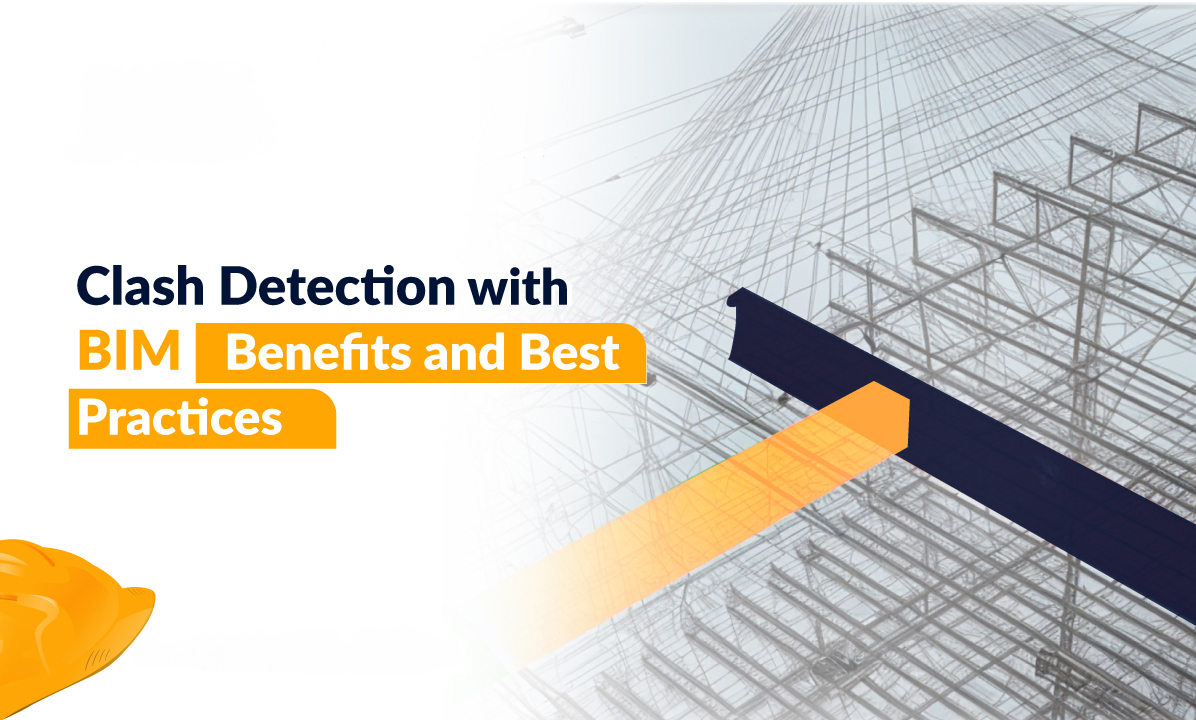
Clash Detection with BIM – Benefits and Best Practices
Various disciplines collaborate on different facets of construction projects. Beginning with the architect's model as a foundation, a structural engineer, environmental engineer, and mechanical and electrical engineer (among others) develop their own model. As data from numerous models converges to create a master model, clashes requiring resolution are bound to arise.
The adoption of Building Information Modeling (BIM) in the construction sector has revolutionized how projects are planned, designed, and built. A critical aspect of this revolution is BIM's role in clash detection—a process vital for identifying and resolving conflicts before they lead to costly delays and reworks.
Clash detection transcends traditional methods by leveraging BIM's dynamic 3D modeling capabilities to identify potential conflicts across architectural, structural, and MEP systems before they materialize on the construction site. By detecting these clashes early in the design and planning phase, teams can resolve issues before physical construction begins, saving time and costs. In this blog, we examine the benefits of BIM in clash detection and some best practices for it.
How BIM Resolves Clashes
The clash detection process, powered by advanced software like Autodesk BIM 360 and Navisworks, becomes a crucible for collaboration, where stakeholders from various disciplines converge to address and resolve conflicts. BIM resolves clashes through a multi-step process:
- Detection: BIM software scans the digital model of the building project, identifying where different systems (like plumbing, electrical, and structural components) interfere with each other. From the tangible collision of a beam and a conduit to the subtle intricacies of workflow disruptions, clashes come in various forms: hard, soft, and workflow or 4D clashes.
- Hard Clashes: Physical conflicts between elements, such as beams and pipes intersecting.
- Soft Clashes: Non-physical interferences, including clearance and maintenance issues.
- Workflow or 4D Clashes: Conflicts related to project scheduling and resource allocation.
- Analysis: It categorizes the detected clashes into types (such as hard clashes, soft clashes, and workflow clashes) to prioritize them based on their potential impact on the project. BIM allows for the creation of detailed clash reports during the design phase. The sophisticated 3D graphics have greatly improved and simplified the clash detection process. This empowers architects and designers to detect conflicts early on in the design process.
- Resolution: Project teams review the clashes collaboratively, using the 3D BIM model to understand the context and explore solutions.
- Adjustment: Solutions are applied to the BIM model, and the design is adjusted to eliminate clashes.
- Verification: The model is rechecked to ensure all identified clashes have been resolved, ensuring the project can proceed without unforeseen issues.
Benefits of BIM in Clash Detection
The key benefits include:
Comprehensive Project Insights and Efficiency
- Streamlined Scheduling and Sequencing: BIM facilitates the optimization of construction schedules by providing a detailed 3D visualization of the project, allowing for easier identification of potential scheduling conflicts and more accurate sequencing of tasks.
- Enhanced Safety and Reduced Risk: By identifying potential design conflicts and hazards before construction begins, BIM significantly minimizes the risk of accidents on-site, ensuring a safer environment for workers and reducing the likelihood of costly delays caused by safety incidents.
- Accurate Cost Estimates and Lower Overall Costs: Clash detection through BIM enables more precise cost estimations by identifying potential issues early on. This foresight helps avoid unexpected expenses, leading to more controlled budgeting and overall cost savings.
- Minimized Material Waste and Sustainability: Early clash detection supports sustainable construction practices by reducing waste. This cuts costs and minimizes the environmental impact of construction projects.
- Improved Quality and Fewer Errors: BIM's clash detection identifies discrepancies during the planning phase, reducing errors across all project stages and ensuring a higher quality of the finished structure.
Enhanced Collaboration and Project Management
- Fostering Collaboration: The collaborative nature of BIM encourages open communication among all stakeholders—architects, engineers, and contractors—enhancing teamwork and leading to more cohesive project execution.
- Streamlined Project Management: BIM clash detection tools often come with integrated project management features that help efficiently track progress, manage assignments, resolve clashes, and promote a smoother workflow.
- Effective Resource Allocation: Identifying and resolving clashes early allows for better allocation of resources, thereby optimizing manpower and materials for higher productivity and efficiency.
Compliance, Client Satisfaction, and Long-Term Benefits
- Ensuring Regulatory Compliance: Clash detection in BIM ensures that projects adhere to all relevant building codes and regulations, reducing the risk of non-compliance issues and associated fines.
- Enhancing Client Satisfaction: Delivering clash-free models contributes to meeting or exceeding client expectations, as projects are more likely to be completed on time and within budget, ensuring higher client satisfaction.
- Risk Mitigation and Long-Term Efficiency: Early detection and resolution of potential issues reduce project risks and ensure the long-term efficiency of building systems, potentially avoiding costly repairs or retrofits after construction completion.
Documentation, Audit Trails, and Risk Management
- Comprehensive Documentation: BIM provides detailed documentation of the clash detection and resolution process, which is invaluable for audits, inspections, and maintaining accurate project records.
- Mitigating Disputes: By reducing design and construction errors, BIM minimizes the chances of disputes among project teams, leading to smoother project execution and stronger stakeholder relationships.
- Stability, Compliance, and Error Reduction: Beyond just avoiding physical clashes, BIM's comprehensive analysis capabilities help in examining the structure's stability, ensuring adherence to regulatory standards, and significantly cutting down on human errors.
Best Practices for Implementing BIM Clash Detection
To maximize the effectiveness of BIM in clash detection, consider the following best practices:
- Early Integration: Implement clash detection during the earliest stages of design. Early detection of potential issues allows for more seamless and cost-effective resolutions, reducing the likelihood of major changes during later stages of the project.
- Comprehensive Modeling: Ensure that the BIM model is as detailed and comprehensive as possible. Including all relevant information—from architectural details to MEP (Mechanical, Electrical, and Plumbing) systems—enhances the accuracy of clash detection.
- Regular Coordination Meetings: Schedule regular meetings involving all project stakeholders to review BIM models and discuss detected clashes. This facilitates open communication, ensures everyone is on the same page, and fosters a collaborative approach to resolving issues.
- Use of Advanced Tools and Software: Utilize advanced BIM and clash detection software that offers robust features for identifying and managing clashes. Tools like Autodesk Revit and Navisworks are widely recognized for their efficiency in managing complex data and facilitating smooth collaboration among different disciplines.
- Categorization of Clashes: Prioritize clashes by categorizing them based on their impact on the project. This helps in addressing the most critical issues first, ensuring that minor problems do not distract from significant conflicts that could halt project progress.
- Clash Resolution Workflow: Develop a clear workflow for resolving detected clashes. This includes assigning responsibilities, setting deadlines for resolution, and documenting the process and outcomes for future reference.
- Leverage Clash Detection Reporting: Generate detailed reports from clash detection exercises to document issues, proposed solutions, and resolutions. This not only helps in keeping track of progress but also serves as a valuable record for future projects.
- Continuous Learning and Adaptation: Learn from each project by reviewing what clashes occurred and how they were resolved. Use these insights to refine your BIM and clash detection processes for future projects.
- Training and Skill Development: Ensure that the team is well-trained in using BIM and clash detection tools. Regular training sessions can help keep the team updated on the latest software features and best practices in clash detection.
- Integrate with Project Management: Integrate clash detection processes with overall project management practices. This ensures that clash detection is not a standalone activity but a key part of the project's lifecycle, contributing to smoother project execution and management.
BIM's role in clash detection has transformed the construction industry, making projects more efficient, cost-effective, and collaborative. By leveraging BIM technology, AEC firms can anticipate and solve conflicts before they escalate, ensuring smoother project execution and better outcomes. Sterling Engineering Support Services specializes in helping engineering firms fully harness the power of designing, drafting, and modeling technologies. Contact us today to learn more about how we can help resolve your project challenges.
To know more about how we can help you
Set Up A Meeting With Our Expert!
All Categories
Recent Posts
MON-SAT 8:00-9:00
+91 69 863 6420




